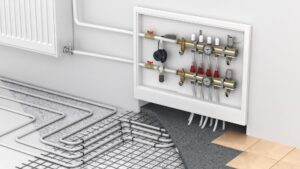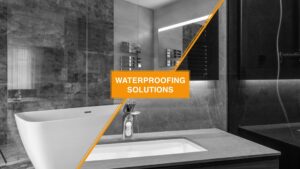In this article, Jim Percival, technical director at Palace Chemicals, explains the importance of movement joints and uncoupling membranes, as well as how to use them properly.
The natural expansion and contraction of tiles is to be expected in areas that change temperature, humidity and moisture. Tile movement is also caused by drying shrinkage, as well as factors external to the tiling system such as settlement and traffic. Without proper measures, however, internal stresses created by floor tile movement can cause tiles to crack or buckle under stress, leading to costly repairs and unsightly appearances.
Movement joints act as buffers between two tiles, or between tiles and other surrounding materials, and are strategically placed to allow for flexibility. Dividing large tiled areas into separate sections, movement joints allow each section to operate independently, which isolates stresses and improves durability. Movement joints can be formed in the floor and wall by using suitable sealants or pre-formed movement joint profiles, typically comprising PVC or metal anchoring legs connected to a flexible synthetic movement zone.
There are two basic types of movement joints in floors: structural or non-structural joints. A structural joint passes through the tile, screed and floor slab and absorbs structural movement such as thermal expansion and contraction. It requires sealants with greater movement capabilities and should always align with the joints in the floor slab. A non-structural joint passes through the tile and screed only and does not penetrate the floor slab, allowing for shrinkage of the floor slab below without damaging the tile above. It is used around the extreme edges of a floor (perimeter joints), for dividing a floor into bays (intermediate joints) and where tiling abuts with other building structures, such as steps, doors and window frames (connecting joints). Required joint width will depend upon factors such as floor dimensions, the screed or bedding system and the tile type.
The recently published document BS 5385-3: 2024 – code of practice for the design and installation of internal and external ceramic and mosaic, natural stone and terrazzo flooring, and internal agglomerated stone flooring in normal conditions – updated its recommendations on movement joints. It emphasises and explains the advised use of movement joints in external tiling: “Exposure to greater fluctuations of thermal and moisture movement means that for external tile installations, intermediate movement joints should be incorporated within the tile assembly at intervals between 3m to 5m. Furthermore, the Standard explains that “depending upon the positioning of the installation (amount of exposure to sunlight and heat), anticipated movement in the substrate, the size, darkness of colour and format of the tiles and slabs selected and the width of the tile joints, further reductions in the distances between intermediate movement joints should be taken into account.”
Another way to separate tiles from their surroundings is by incorporating uncoupling membranes, which act as a protective intermediary between the substrate and the tile layer. Direct bonding of tiles can be problematic with some substrates as tensions can be transferred directly to the tile covering. By absorbing stresses from lateral movement and temperature fluctuations, the introduction of uncoupling membranes significantly reduces the risk of cracking or shifting tiles over time. Low-profile uncoupling membranes, such as 0.7mm thick Palace EASI-MAT, can be easily accommodated beneath tiling.
Since movement joints and uncoupling membranes are key to the lasting success of a tiling project, it is important to consider and plan their use from the beginning stages, as well as the role they play in the overall tile design. In both cases, the effectiveness of the barrier relies heavily on selecting an appropriate flexible S1 adhesive; they must allow for movement within the membrane without compromising bond strength. Flexible adhesives not only adhere to surfaces but also absorb vibration and shock, supporting the function of movement joints and uncoupling membranes.
The use of uncoupling membranes in conjunction with flexible adhesives, designed to absorb and mitigate tile stress, can reduce the amount of movement joints required to a tiled area in the long term. These help not only to save costs but improves the sustainability of a tile system, making them critical elements to any good tiling job.





